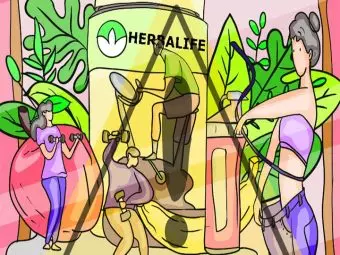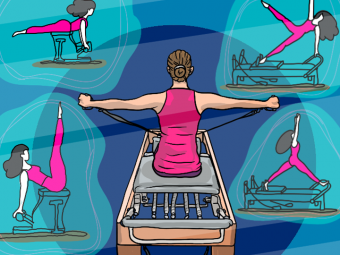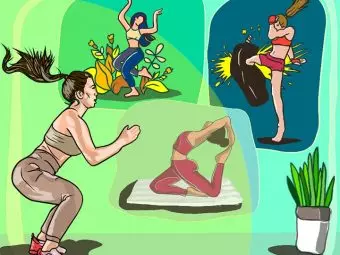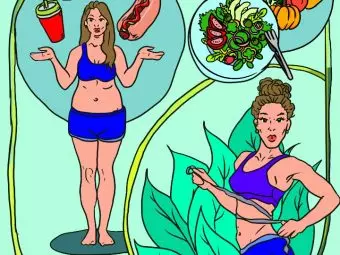Lower belly fat is not only a cosmetic issue but also can negatively affect your overall health. But worry not – as we have brought to you some tips to reduce lower belly fat.
As per an estimate, 60% of the population suffers from belly fat in the US (1). It has become a global health issue. It is also linked to diabetes as visceral fat may cause insulin resistance (2). It is also related to impairing insulin sensitivity in the muscle tissue and the liver (3). All these factors may increase the risk of metabolic disease. Hence, lower belly fat should be addressed immediately without any delay.
While lower belly fat is harmful, you can reduce it by following certain tips. Continue reading to know more.
You can measure your belly fat at home by using a simple measuring tape. Measure your waist and hip circumference to get the ratio.
According to the WHO, a healthy waist to hip ratio (WHR) is 0.80 or less in women and 0.90 or less in men. A WHR of 1 or more indicates abdominal obesity or belly fat (4).
How To Reduce Lower Belly Fat
There are no fast tricks to get rid of lower belly fat. You need to have a holistic approach (exercise, diet, and lifestyle management) to obtain positive and sustainable results.
1. Exercise
Exercise is one of the most effective ways to lower belly fat. However, focusing only on ab and core exercises is not going to help out. Spot reduction of the fat around your belly is not possible.
A study on 24 healthy individuals doing abdominal exercise for six weeks showed no significant benefit in reducing abdominal fat (5). Instead, you need to target different muscle groups with aerobic exercises. Several studies have found that aerobic exercises can help reduce belly fat (6).
Try out different forms of exercises – like strength training, cardio, and aerobic exercises – for better results. On your abs days, do the following exercises with some cardio to target your core muscles :
- Leg Raises – 3 sets of 15 reps
- Scissor Kicks – 3 sets of 15 reps
- Leg In And Out – 3 sets of 15 reps
- Standing Alternate Leg Kicks – 3 sets of 15 reps
- Lying Leg Curls – 3 sets of 15 reps
- Mountain Climbers – 3 sets of 15 reps
- Bicycle Crunches – 3 sets of 15 reps
- Russian Twists – 3 sets of 20 reps
- Burpees – 3 sets of 10 reps
- Flutter Kicks – 3 sets of 20 reps
- Superman – 2 sets of 3 reps
2. Healthy Diet
- Cut Down On Carbs
Cutting down on carbs is extremely beneficial in reducing excess belly fat. A low-carb diet decreases a few pounds quickly as it releases water from the body. In a study conducted at the Haimoto Clinic (Japan), 63 people (men and women) on a low-carb diet showed a reduction in belly fat, subcutaneous fat, and waist circumference (7).
Limiting carb intake to 100 g/day, consuming more fruits and vegetables, replacing grains with whole grains, and portion control are important to kick start your weight loss. The dietary fiber in whole grains improves satiety to aid weight loss (8). The bioactive compounds in fruits and vegetables help in various cellular reactions and processes (9).
- Include Protein In Every Meal
A study carried on 27 overweight/obese men by the University of Missouri found that a high-protein diet improves appetite control and satiety to promote weight loss (10).
Proteins take longer to digest and release PYY, a gut hormone that decreases appetite and promotes satiety (11). They also help build lean muscle mass, a site where a number of mitochondria (cell organelles in which sugar gets converted to usable energy) are present, boosting up metabolism (12).
You should aim for a 25-30% protein intake of total calories. Use coconut oil for grilling or sautéing your protein as a study has shown that medium- and long-chain triacylglycerol (MLCT) suppresses body fat accumulation in humans (13).
- Consume Healthy Fats
Healthy fats are a great way to reduce inflammation in the body. Chronic inflammation is directly linked to obesity. Include polyunsaturated fats like olive oil, avocado, nuts, and seeds, clarified butter, fatty fish rich in omega-3 fatty acids in your diet to lower inflammation (14).
- Bulk Up On Fiber
When the soluble fiber found in fruits, vegetables, and whole grains is fermented in the large intestine, it produces two gut hormones – glucagon-like peptide (GLP-1) and peptide YY (PYY). These hormones increase satiety (15). The best ways to incorporate fiber in the diet is being regular with your fruit and vegetable intake, replacing regular grains with whole grains, and adding legumes to your diet.
- Avoid Refined Sugar
If you want to lose belly fat, you need to avoid refined sugar in any form – colas, candies, chocolates, cakes, cookies, etc. Many studies have shown that consumption of sugar-sweetened beverages increases the chances of obesity. A positive correlation was established between the intake of sugary beverages and weight gain/obesity among children and adults (16).
Use jaggery, dark brown sugar, organic honey, and organic maple syrup instead of refined sugar when you crave something sweet.
- Drink Green Tea
Green tea is the perfect detox drink when you are trying to lose belly fat. It contains caffeine and EGCG (epigallocatechin gallate), which can have powerful effects on metabolism. It helps nullify the harmful effects of free oxygen radicals, thereby preventing toxin accumulation (17). The effect may be strengthened when green tea consumption is combined with exercise.
Have two to three cups (8 fluid ounces) of green tea per day.
- Stay Hydrated
Staying hydrated is the key to flushing out toxins. Consume less energy-dense (low-calorie) foods to lose weight. Drinking 500 ml water 30 minutes before a meal can lead to moderate weight loss (18).
A study in The Journal of Clinical Endocrinology and Metabolism states that drinking 500 ml of water increases metabolic rate by 30% because of water-induced thermogenesis. This can be beneficial for weight loss (19).
Subscribe
3. Lifestyle Management
If you are following a great diet but still not losing your belly fat, then your lifestyle could be to blame. Stress, inadequate sleep, and bad lifestyle habits are the major culprits of belly fat.
- Stress Management
Stress and weight gain are interconnected. A study published in Obesity Research states that uncontrollable stress increases the cortisol levels in your body, which causes fat deposition in the abdomen area (20). This increase in cortisol levels can also increase the urge for “comfort foods” like refined carbs, fried foods, and sweets. These foods cause fat deposition, specifically in the abdominal area (21). A few things you can do to reduce stress are:
- Do deep breathing exercises in the early morning and before going to bed.
- Walk outdoors for 15-20 minutes (slow pace work) to get some fresh air.
- Spend some time on a hobby you enjoy.
- Take some time out from your busy schedule to enjoy with your family and friends.
- Proper Sleep
Sleep helps recharge your body and mind. Sleep deprivation increases inflammation and toxin build-up in the body. A study published in Obesity Journal on obese women showed that sleeping more than 7 hours per night increased the likelihood of weight-loss success (22). Therefore, the quality and quantity of sleep are vital factors in losing belly fat.
It is important to lose belly fat as it can impact your insulin resistance and sensitivity. But, you cannot lose belly fat overnight or in a week. Belly, or abdominal, fat is very stubborn and only reduces with a long-term weight loss strategy. This strategy, as mentioned above, should incorporate a daily exercise regimen paired with a balanced and nutritious diet and a healthy lifestyle. You may not notice any weight reduction right at the beginning, but stick to this strategy to see long-term results. Along with following the above tips to reduce lower belly fat, you should also take steps to reduce stress.
Frequently Asked Questions
Is lower belly fat hard to lose?
Yes, lower belly fat is stubborn and difficult to lose than fat from other areas of the body due to the presence of beta fat cells in the lower belly region.
How can I lose my lower belly fat in 3 days?
You cannot spot reduce fat from the lower belly region. However, you may see a difference in lower belly fat with proper sleep, adequate hydration, protein intake, and high intensity interval training combined with core strengthening exercises and by avoiding sugary or inflammatory foods.
Do planks burn lower belly fat?
Planks help strengthen the core muscles which in turn help burn more calories, leading to lower belly fat loss.
Do squats burn lower belly fat?
Squats do not help spot reduce belly fat, but it helps build muscles and lose calories, which can lead to a reduction in lower belly fat.
Sources
Articles on StyleCraze are backed by verified information from peer-reviewed and academic research papers, reputed organizations, research institutions, and medical associations to ensure accuracy and relevance. Check out our editorial policy for further details.
- Indicator Details: Percentage with Abdominal Obesity by Survey Year, Centers for Disease Control and Prevention.
https://nccd.cdc.gov/ckd/detail.aspx?Qnum=Q146 - Insulin resistance: definition and consequences, Experimental and Clinical Endocrinology & Diabetes, US National Library of Medicine, National Institutes of Health.
https://www.ncbi.nlm.nih.gov/pubmed/11460565 - What causes the insulin resistance underlying obesity?Current Opinion In Endocrinology, Diabetes, and Obesity, US National Library of Medicine, National Institutes of Health.
https://www.ncbi.nlm.nih.gov/pmc/articles/PMC4038351/ - Waist Circumference and Waist-Hip Ratio, Report of a WHO Expert Consultation, World Health Organization.
https://apps.who.int/iris/bitstream/handle/10665/44583/9789241501491_eng.pdf;jsessionid=B75820A2C301B29DA1FE75C7ADDE596B?sequence=1 - The effect of abdominal exercise on abdominal fat, Journal of Strength and Conditioning Research, US National Library of Medicine, National Institutes of Health.
https://www.ncbi.nlm.nih.gov/pubmed/21804427 - A systematic review and meta-analysis of the effect of aerobic vs. resistance exercise training on visceral fat, Obesity Reviews, US National Library of Medicine, National Institutes of Health.
https://www.ncbi.nlm.nih.gov/pubmed/21951360 - Effects of a moderate low-carbohydrate diet on preferential abdominal fat loss and cardiovascular risk factors in patients with type 2 diabetes, Diabetes, Metabolic Syndrome and Obesity: Targets and Therapy, US National Library of Medicine, National Institutes of Health.
https://www.ncbi.nlm.nih.gov/pmc/articles/PMC3138148/ - Dietary fiber and satiety: the effects of oats on satiety, Nutrition Reviews, US National Library of Medicine, National Institutes of Health.
https://www.ncbi.nlm.nih.gov/pmc/articles/PMC4757923/ - Health-Promoting Components of Fruits and Vegetables in the Diet, Advances in Nutrition, US National Library of Medicine, National Institutes of Health.
https://www.ncbi.nlm.nih.gov/pmc/articles/PMC3650511/ - The effects of consuming frequent, higher protein meals on appetite and satiety during weight loss in overweight/obese men, Obesity, US National Library of Medicine, National Institutes of Health.
https://www.ncbi.nlm.nih.gov/pubmed/20847729 - A high-protein diet for reducing body fat: mechanisms and possible caveats, Nutrition & Metabolism, US National Library of Medicine, National Institutes of Health.
https://www.ncbi.nlm.nih.gov/pmc/articles/PMC4258944/ - Chapter 2 – Anatomy of Skeletal Muscle and Its Vascular Supply, Skeletal Muscle Circulation, US National Library of Medicine, National Institutes of Health.
https://www.ncbi.nlm.nih.gov/books/NBK57140/ - The application of medium-chain fatty acids: edible oil with a suppressing effect on body fat accumulation, Asia Pacific Journal of Clinical Nutrition, US National Library of Medicine, National Institutes of Health.
https://www.ncbi.nlm.nih.gov/pubmed/18296368 - N-3 Polyunsaturated Fatty Acids and Inflammation in Obesity: Local Effect and Systemic Benefit, BioMed Research International, US National Library of Medicine, National Institutes of Health.
https://www.ncbi.nlm.nih.gov/pmc/articles/PMC4538411/ - Dietary Fibre and Its Effect on Health, International Journal of Research and Analytical Reviews.
http://ijrar.com/upload_issue/ijrar_issue_558.pdf - Intake of sugar-sweetened beverages and weight gain: a systematic review, The American Journal of Clinical Nutrition, US National Library of Medicine, National Institutes of Health.
https://www.ncbi.nlm.nih.gov/pmc/articles/PMC3210834/ - Epigallocatechin Gallate Is the Most Effective Catechin Against Antioxidant Stress via Hydrogen Peroxide and Radical Scavenging Activity, Medical Science Monitor, US National Library of Medicine, National Institutes of Health.
https://www.ncbi.nlm.nih.gov/pmc/articles/PMC6247744/ - Efficacy of water preloading before main meals as a strategy for weight loss in primary care patients with obesity: RCT, Obesity, US National Library of Medicine, National Institutes of Health.
https://www.ncbi.nlm.nih.gov/pubmed/26237305/ - Water-induced thermogenesis, The Journal of Clinical Endocrinology and Metabolism, US National Library of Medicine, National Institutes of Health.
https://www.ncbi.nlm.nih.gov/pubmed/14671205 - Stress-induced cortisol response and fat distribution in women, Obesity Research, US National Library of Medicine, National Institutes of Health.
https://www.ncbi.nlm.nih.gov/pubmed/16353426 - Stress and Obesity: Are There More Susceptible Individuals?Current Obesity Reports, US National Library of Medicine, National Institutes of Health.
https://www.ncbi.nlm.nih.gov/pmc/articles/PMC5958156/ - Relationship between sleep quality and quantity and weight loss in women participating in a weight-loss intervention trial, Obesity, US National Library of Medicine, National Institutes of Health.
https://www.ncbi.nlm.nih.gov/pubmed/22402738
Related
The following two tabs change content below.
- Author
- Reviewer
Charushila Biswas
Charushila is an ISSA certified Fitness Nutritionist and a Physical Exercise Therapist. Over a span of 5 years, she has… more
Merlin Annie Raj
(Registered Dietitian Nutritionist)Merlin Annie Raj is a Registered Dietitian based out of Hyderabad, India. She has vast experience in Clinical Nutrition as… more



 Herbalife For Weight Loss: Effectiveness, Pros, And Cons
Herbalife For Weight Loss: Effectiveness, Pros, And Cons Is Liquid Diet Good For Weight Loss? Types, Menu Plan, Benefits & Side Effects
Is Liquid Diet Good For Weight Loss? Types, Menu Plan, Benefits & Side Effects 15 Arm Workouts Without Weights To Lose Arm Fat Fast At Home
15 Arm Workouts Without Weights To Lose Arm Fat Fast At Home Can Sauna Aid Weight Loss? How Does It Work?
Can Sauna Aid Weight Loss? How Does It Work? 10 Best Pilates Reformer Exercises And Benefits For A Fit Body
10 Best Pilates Reformer Exercises And Benefits For A Fit Body Burn 500 Calories A Day Fast: The 12 Best Workouts
Burn 500 Calories A Day Fast: The 12 Best Workouts Easy Diet Plan To Reduce Belly Fat
Easy Diet Plan To Reduce Belly Fat A 7-Day Healthy 2000-Calorie Diet Plan For Weight Loss
A 7-Day Healthy 2000-Calorie Diet Plan For Weight Loss 7 Unknown Reasons For Weight Gain During Your Period
7 Unknown Reasons For Weight Gain During Your Period